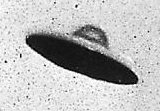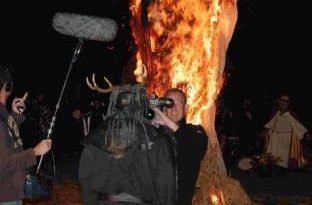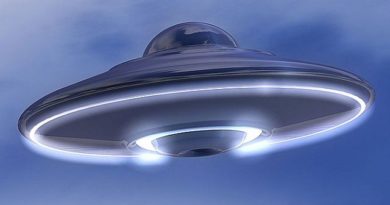UFOs, UAPs—Whatever We Call Them, Why Do We Assume Mysterious Flying Objects Are Extraterrestrial?

Earlier this summer, the Office of the Director of National Intelligence (ODNI) released a much publicized nine-page report titled, with deliberate blandness, “Preliminary Assessment: Unidentified Aerial Phenomena.” Although the report was requested by Congress, in many ways it was the culmination of three-and-a-half years of public attention to military reports regarding unidentified flying objects. ODNI did not use the acronym “UFO,” which dates back to the 1950s (government officials now prefer “UAP,” for unidentified aerial phenomena), and never even mentioned the possibility of an extraterrestrial origin for the sighted objects. But that didn’t keep news outlets from concluding that the report “stops short of ruling out aliens.”
Military and intelligence officials have consistently framed these mysterious incidents in terms of national security. The Preliminary Assessment stated that ODNI’s charge from Congress was to provide policymakers with an overview of “the challenges associated with characterizing the potential threat posed by UAP.” The office was directed to focus on “identification of potential aerospace or other threats posed by the unidentified aerial phenomena to national security, and an assessment of whether this unidentified aerial phenomena activity may be attributed to one or more foreign adversaries.” Even those who promote the study of UFOs agreed that possible military threats—not extraterrestrials—were the focus of the new report.
So why do the press and social media keep bringing up aliens? Because, for better or worse, sightings of unidentifiable things in the sky have become inextricably linked to visitors from outer space. Aliens are now our default explanation for such events, and the reason is no accident: For nearly 75 years, people have worked hard to make it the default.
When reports of flying saucers first began to surface during the summer of 1947, extraterrestrials were hardly brought up. Yes, there were some who took seriously the prospect that Martians or other beings from outer space were behind all the commotion. Kenneth Arnold—the man credited with first reporting a UFO sighting—is said to have encountered a distraught woman in an Oregon café, who ran out sobbing and shouting, “There’s the man who saw the men from Mars,” adding that she “would have to do something for the children.”
Most people, though, didn’t take this possibility seriously. Opinion writers tended to think it most likely that the U.S. or Soviet Union were testing experimental rockets or aircraft. The general public also seemed dubious that flying saucers might be the work of extraterrestrials. In August 1947, George Gallup published the results of a poll in which he asked those surveyed—all Americans—what they thought the flying objects reported in the newspapers might be. Twenty-nine percent thought witnesses had been mistaken, 15 percent thought they were secret American weapons, and one-third said they didn’t know. If there were people who believed they were ships from outer space, their responses were included among the nine percent who answered “other.”
A Dutch survey in October 1952 revealed similar sentiments in the Netherlands, with no apparent support for the idea of alien visitors. And 43 percent confessed that they had no idea what the flying saucers were.
The fact that almost half the general public in the late 1940s and early 1950s were undecided about the nature of UFOs meant that, in principle at least, they were open to different explanations. This provided an opportunity in 1950 for pulp and entertainment writers Donald Keyhoe (The Flying Saucers are Real), Frank Scully (Behind the Flying Saucers), and Gerald Heard (The Riddle of the Flying Saucers) to find receptive readers for their claims that unidentified flying objects were visitors from outer space. Over the course of the 1950s, first local, then nationwide flying saucer clubs and groups sprouted up across the United States. These offered subscribers both a way to keep up with UFO news through newsletters and bulletins, and a forum for speculating about the intentions of the extraterrestrials free from fear of public ridicule.
By 1956, the terms “unidentified flying object” and “UFO” were being used in place of “flying saucer” by some military officials and amateur civilian researchers. Within a decade and a half, the acronym UFO had effectively replaced its predecessor. If the new terminology was meant to bring precision to reports of sightings, however, it achieved nothing of the kind. Just as any account of an odd thing in the sky had been quickly branded by media outlets to be a potential flying saucer, so too “UFO” served as a convenient rubric under which the media categorized just about any perplexing observation. All the while, “UFO” continued to carry with it the same association with aliens that “flying saucer” once had. The current term, “unidentified aerial phenomena” is a prisoner of this same past.
What then, should we make of this most recent report? Does it add anything new to the long history of UFOlogy? How does it compare with previous official statements?
Unfortunately, the document is thin on details, so there is much we don’t know. What we have been told, however, is that the Department of Defense has formed an Unidentified Aerial Phenomena Task Force (UAPTF) to study the issue. For the purposes of the report, this task force examined 144 incidents involving U.S. government personnel and assets, all of which occurred between November 2004 and March 2021. Most of the cases are considered explainable, though they haven’t all been completely explained due to the fact that “the reporting lacked sufficient specificity.”
The most worrying UAP episodes for national security-minded readers involved 18 outlier instances in which it was reported that the object displayed “unusual flight characteristics.” In these cases, investigators could not rule out the possibility that it was the result of sensor errors, cyberattack, or misperception. In the end, intelligence authorities recommend increased funding to the task force to develop a more robust data collection and analysis system.
This is by no means the first government fact-finding effort in this arena. After 1947, the U.S. Air Force established a series of UFO investigation task forces, the most prominent being Project Blue Book during the years 1952-1969. In 1953, the Central Intelligence Agency convened a small panel of consultants to look into the matter. Finally, the Air Force sponsored a scientific study of the UFO phenomenon by the University of Colorado between 1966 and 1968.
Civilian UFO researchers and enthusiasts have soundly criticized these undertakings for what they see as evidence of bias and secrecy. Nevertheless, in all these cases, officials publicly concluded that most reports of UFOs were explicable and presented no reason for concern, and that the residue of inexplicable cases did not pose a national security threat.
In short, the ODNI Preliminary Assessment is all too familiar. Modern investigation of UAPs has been hampered by inconsistent standards of reporting and limited resources, and as in the past, officials on the whole appear unruffled by such reports. And once again, government agencies leave room for ambiguity in admitting that there are a number of anomalous incidents.
ODNI’s preliminary report does break some new ground, however. It clearly states that most unidentified aerial phenomena reported are physical objects. It also admits that a culture of dismissiveness and ridicule within the military and intelligence communities has inhibited witnesses from coming forward, which may partly explain the shortcomings in reporting. In fact, the Preliminary Assessment appears to open the way for more scientists and technical experts to join the discussion, although how they should do that remains unclear.
We can expect that intelligence analysts will continue to monitor the situation. Activists will take to social media to demand full disclosure by government agencies. And both skeptics and believers in alien visitation will come away feeling that their side has won the day. Far from the end of the UFO controversy, this is just the beginning of a new chapter.
*** This article has been archived for your research. The original version from Air & Space Magazine can be found here ***


